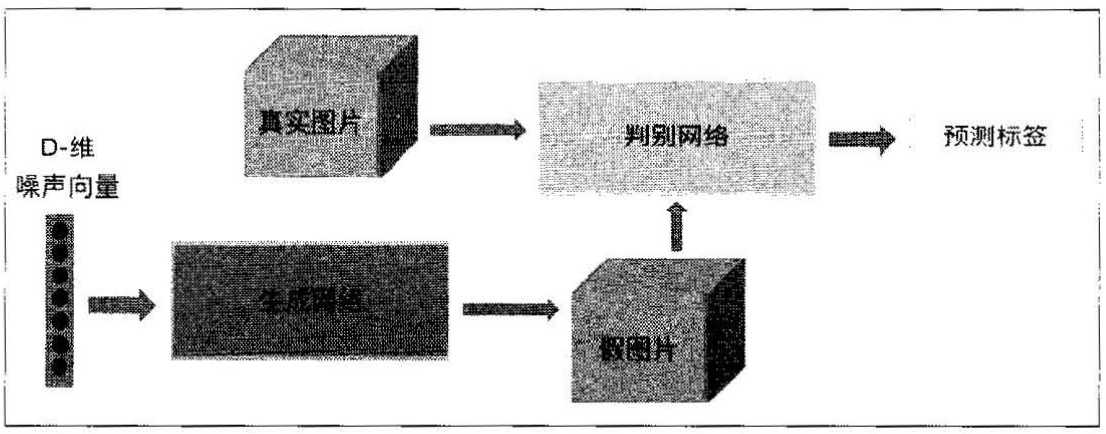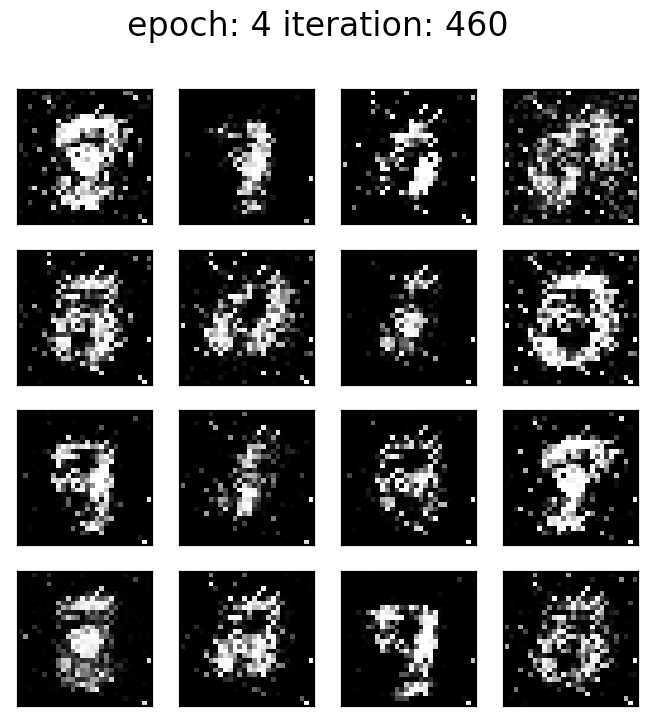标签:imp style ISE 使用 use blank target beta 训练
生成对抗网络(Generative Adversarial Network, GAN)包括生成网络和对抗网络两部分。生成网络像自动编码器的解码器,能够生成数据,比如生成一张图片。对抗网络用来判断数据的真假,比如是真图片还是假图片,真图片是拍摄得到的,假图片是生成网络生成的。
生成对抗网络就是让生成网络和对抗网络相互竞争,通过生成网络来生成假的数据,对抗网络判别该数据是真是假,最后希望生成网络生成的数据以假乱真骗过判别器。

以下程序主要来自廖星宇的《深度学习之PyTorch》的第六章,本文对原代码进行了改进:
import torch
from torch import nn
import torchvision.transforms as tfs
from torch.utils.data import DataLoader
from torchvision.datasets import MNIST
import numpy as np
import matplotlib.pyplot as plt
def preprocess_img(x):
x = tfs.ToTensor()(x) # x (0., 1.)
return (x - 0.5) / 0.5 # x (-1., 1.)
def deprocess_img(x): # x (-1., 1.)
return (x + 1.0) / 2.0 # x (0., 1.)
def discriminator():
net = nn.Sequential(
nn.Linear(784, 256),
nn.LeakyReLU(0.2),
nn.Linear(256, 256),
nn.LeakyReLU(0.2),
nn.Linear(256, 1),
)
return net
def generator(noise_dim):
net = nn.Sequential(
nn.Linear(noise_dim, 1024),
nn.ReLU(True),
nn.Linear(1024, 1024),
nn.ReLU(True),
nn.Linear(1024, 784),
nn.Tanh(),
)
return net
def discriminator_loss(logits_real, logits_fake): # 判别器的loss
size = logits_real.shape[0]
true_labels = torch.ones(size, 1).float()
false_labels = torch.zeros(size, 1).float()
bce_loss = nn.BCEWithLogitsLoss()
loss = bce_loss(logits_real, true_labels) + bce_loss(logits_fake, false_labels)
return loss
def generator_loss(logits_fake): # 生成器的 loss
size = logits_fake.shape[0]
true_labels = torch.ones(size, 1).float()
bce_loss = nn.BCEWithLogitsLoss()
loss = bce_loss(logits_fake, true_labels)
return loss
# 使用 adam 来进行训练,beta1 是 0.5, beta2 是 0.999
def get_optimizer(net, LearningRate):
optimizer = torch.optim.Adam(net.parameters(), lr=LearningRate, betas=(0.5, 0.999))
return optimizer
def train_a_gan(D_net, G_net, D_optimizer, G_optimizer, discriminator_loss, generator_loss,
noise_size, num_epochs, num_img):
f, a = plt.subplots(num_img, num_img, figsize=(num_img, num_img))
plt.ion() # Turn the interactive mode on, continuously plot
for epoch in range(num_epochs):
for iteration, (x, _)in enumerate(train_data):
bs = x.shape[0]
# 训练判别网络
real_data = x.view(bs, -1) # 真实数据
logits_real = D_net(real_data) # 判别网络得分
rand_noise = (torch.rand(bs, noise_size) - 0.5) / 0.5 # -1 ~ 1 的均匀分布
fake_images = G_net(rand_noise) # 生成的假的数据
logits_fake = D_net(fake_images) # 判别网络得分
d_total_error = discriminator_loss(logits_real, logits_fake) # 判别器的 loss
D_optimizer.zero_grad()
d_total_error.backward()
D_optimizer.step() # 优化判别网络
# 训练生成网络
rand_noise = (torch.rand(bs, noise_size) - 0.5) / 0.5 # -1 ~ 1 的均匀分布
fake_images = G_net(rand_noise) # 生成的假的数据
gen_logits_fake = D_net(fake_images)
g_error = generator_loss(gen_logits_fake) # 生成网络的 loss
G_optimizer.zero_grad()
g_error.backward()
G_optimizer.step() # 优化生成网络
if iteration % 20 == 0:
print(‘Epoch: {:2d} | Iter: {:<4d} | D: {:.4f} | G:{:.4f}‘.format(epoch,
iteration,
d_total_error.data.numpy(),
g_error.data.numpy()))
imgs_numpy = deprocess_img(fake_images.data.cpu().numpy())
for i in range(num_img ** 2):
a[i // num_img][i % num_img].imshow(np.reshape(imgs_numpy[i], (28, 28)), cmap=‘gray‘)
a[i // num_img][i % num_img].set_xticks(())
a[i // num_img][i % num_img].set_yticks(())
plt.suptitle(‘epoch: {} iteration: {}‘.format(epoch, iteration))
plt.pause(0.01)
plt.ioff()
plt.show()
if __name__ == ‘__main__‘:
EPOCH = 5
BATCH_SIZE = 128
LR = 5e-4
NOISE_DIM = 96
NUM_IMAGE = 4 # for showing images when training
train_set = MNIST(root=‘/Users/wangpeng/Desktop/all/CS/Courses/Deep Learning/mofan_PyTorch/mnist/‘,
train=True,
download=False,
transform=preprocess_img)
train_data = DataLoader(train_set, batch_size=BATCH_SIZE, shuffle=True)
D = discriminator()
G = generator(NOISE_DIM)
D_optim = get_optimizer(D, LR)
G_optim = get_optimizer(G, LR)
train_a_gan(D, G, D_optim, G_optim, discriminator_loss, generator_loss, NOISE_DIM, EPOCH, NUM_IMAGE)
效果:

标签:imp style ISE 使用 use blank target beta 训练
原文地址:https://www.cnblogs.com/picassooo/p/12601909.html